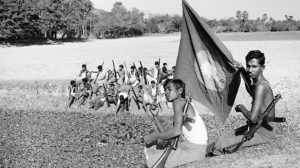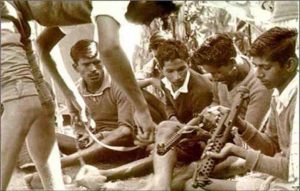1952- Language movement, 1954- Election, 1962- Education movement, 1966 – Claim of Autonomy 1966-69 – Mass coup, 1970 – Great victory in Election and after that war of independence began under the great leadership of Sheikh Mujibor Rahman. “ War of this time ………is the war of independence” Victory of Bengal…… Padma, Megna, Jamuna…….. Your & mind identity. Such slogans were the inspiration of people for the liberation War. Participation of all classes of people of Kaligonj in Satkhira in the war was the burning history of the country.

Our country was divided into several sectors for the operation the war of independence properly. Satkhira distict was under of 8th & 9th sectors. “Bhomra” was the first “Camp” ever of 8th & 9th sectors. With the assistance of local community EPR & Police forces, a training camp was established from the very first beginning of the liberation war. Major MA Jolil, Major Joinul Abedin, Abu Osman Chowdhury & MA Monjur Were in charge as sector commanders here.
Besides, A few sub- sector commanders were also engaged for the first operation. They were- 1. Captain Shafikulla, 2. Cap. Mahabub Ahmed 3. Cap. Md. Shahajan 4. Cap. M.N Huda 5. Cap. Ziauddin 6. Lt.G Mahfuz Alom Beg 7. Lt. Samsul Arafin along with Abdul Gofur, Momtazuddin M.P, Sk. Amanullah, SM. Alauddin, AFM Enataz Ali, Syed Kalam Box Saki MP, SM. Fozlul Huq, Sk. Woahiduzzaman, Babor Ali, Atiar Rahman, Nazrul Islam of Barisal, Lutfor Rahman, Abdul Mozid, Kazi Kamal Sottu, Mir Easrat Ali, Moshtafizur Rahman, Azibar Rahman, Kamrul Islam Khan, Khairul Bashar, Enamul Huq and many unknown persons were also acted as organizers. Sheikh Mujib asked all for the independence on 7th March, 1971 and all Bengal became fiery at his speech. Peaceful Kaligonj became billowy. To organize well, Kaligonj battle council was built with 23 members. Under the leadership of battle council members, the Pak Flag was burnt on March at Dakbangla permises.

A “Stick procession” (Lathi Misil) with inflammatory slogans was also arranged at Kaligonj. The people of all sectors of Kaligonj became United and prepared themselves for creating “Defence Camp” at Kaligonj. There was a rumor that the Pak Army were coming to Kaligonj by channel (Kakshaly River) on to April 10/11. Hearing that – all “Battle Council” members became excited with rage. All armed members became organized and took position in the brushwood by river along Kaligonj Bazar to police station. Overcoming all obstacles hundreds of young people took oath for joining the war of independence.
The role of young generations and students was noticable. For taking training, the young guies swam accross the river Isamoti to join to Hingol Gonj ( India, 24 Porgona, West Bengal) training centre. Among then, Sk. Shabuddin, Abdul Khalek, Md. Golam and others joined the “Bihar Training Camp”for being skilled fighter with the inspiration of Captain Shahajan(Master). They began to take training under the trainers of Confederate Army. Most of the trainers of India spoke Hindi Language. Sk. Shabuddin, a trainee at Chakulia camp (7th innings), Bihar as well as a student of captain Shahajan Master acted as a translator and later on he became a trainer of that group. Peace committee, Al- Bodor, Razakar were also built for collecting the movement news of our freedom fighters by the Pak attendents. Al-Bodor, Al-Sams, Razakar began torturing on the local people to create affection for Pakistan. Pak army built their haunts at WAPDA Dak-Bangla building, Abanded house of Chandradev at Vasantapur, Kaligonj Hospital area, Domdom Ferry Ghat ice mill, EPI Camp at Khanjia and later on they built haunts at Sadpur bridge, Varashimla, Suilpur, Nazimgonj, Vosontopur, Uksha and Pirojpur.
The freedom fighters began to take training at different places in India urgently. Within May they returned home for taking part to the war.Captain Major Jalil of sector 9 and his fellow assistant captain Nurul Huda, LT Beg, LT Arafin and Shocin Day continued many attacks against Pak Army upto Nov 20. To occupy Kaligonj, the Pak Army engaged about hundreds of regular informers there. Aboout 500 freedom fighters invaded the well armed Pak Army there. At first the fighters attacked Vosontopur BOP, Khanjia camp and BOP camp at Kaligonj. Next they attacked Bagbati, Pirojpur, Varasimla, Rotonpur, Nazimgonj, Dudli and other Pak army camps and overthrew them.
Kaligonj became a battle field near Nov & Dec 1971. Kaligonj became trembled at the sound of attack and counter-attack. Uksha BOP, Pirozpur and Khanjia fightings were notable. At the last stage of liberation war, the people of Kaligonj Confronted Pak army.
Some memories of Kaligonj battle
June 13/1971.
Vosontopur Pak army camp was attacked under the leadership of sub-sector commander captain Nurul Huda with 35 freedom fighters and 20 Pak soldiers were killed.
2nd Week of July, 1971—
By the direction of Major Jalil, Captain Nurul Huda attacked Khanjia BOP camp along with 160 freedom fighters. About 30 minutes they continued fighting and Pak army fell a victim to heavy loss and they were compelled to skedaddle away and took shelters at Satkhira and Parulia area. 4 Pak army were injured and caught by the freedom fighters.
Aug 30, 1971—
A troop of 400 Pak army ambushed the Uksha-Govindopur camp of freedom fighters and a fierce fighting was occurred. The fighting continued for about 9 hours from 9 A.M to 4.00 P.M. The Pak army were defeated and drove away from that area. 8 Pak soldiers were killed by “mine blast” of freedom fighters. Pak army escaped away with the wounded Major. As Pak soldiers died by this battle falling in the trap by the freedom fighters there, it was known as “Uksha Death Trap”.
Sep 4, 1971—
Pak army attacked the freedom fighters camp at Pirojpur and there was a serious fighting. Many Pak soldiers and Razakar were also killed there.
Sep 26, 1971—
Under the leadership of Commander Sk. Woahaduzzaman and Sub-Sec Commander, Lt. Mahfuz Alom Beg, the freedom fighters attacked Kaligonj Razakar camp and they were compelled to surrender. The freedom fighters also seized a few guns through an operation to National Bank of Pakistan at the same day.
Sep 29, 1971—
The Pak army attacked the Dudli freedom fighters camp and there was a weak fighting. Commander Sk. Woaheduzzaman ordered his fellow fighters to leave that place as they would not be able to fight against Pak army as they (Pak Army) had heavy weapons. Freedom fighters Rojob Ali was seriously injured.
Nov 20, 1971 —-
At about 5 A.M, the freedom fighters attacked the Pak soldier’s camp at Kaligonj WAPPA. In two hours battle, the Pak soldiers were captive. 40 Pak soldiers were caught in that battle. LT. Ahsanulla captured 22 and Naik Subeder Gofur captured 6 Pak soldiers respectively. Many soldiers of Pakistan escaped and took shelter at Alipur and Satkhira. At last, Kaligonj became released.
Within moments, the news was spread around and people of all classes came to the Dakbangla with flags in their hands. That moment is ever lasting moment. Since then, that day is observed as “Kaligonj Released Day.” It will remain memorable in the history of the Liberation war of Bangladesh.
Writer and Journilist
Selim Sharier
Station Manager, Radio Nalta.























